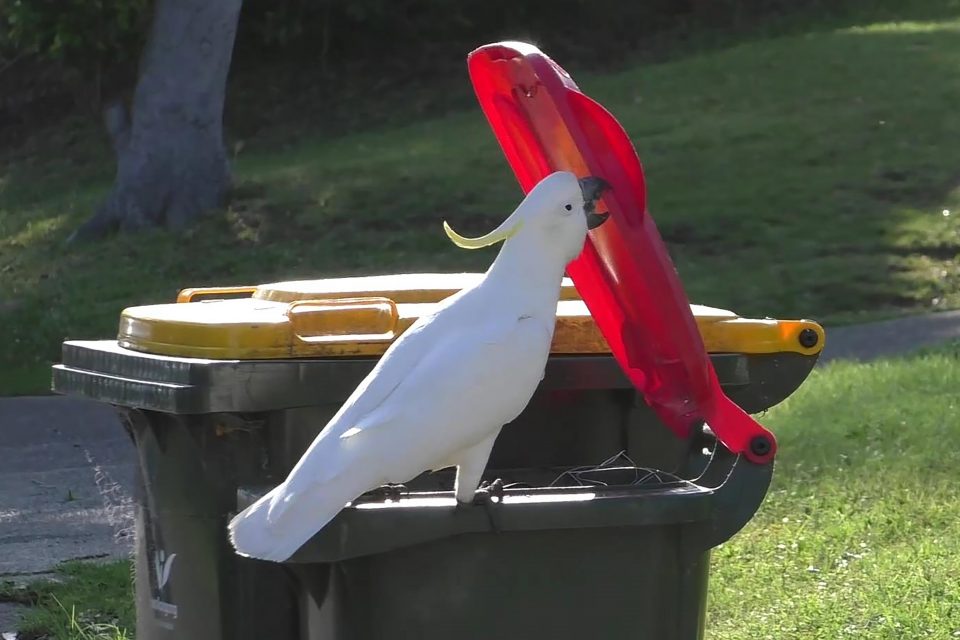You have heard of trash pandas: Raccoons raiding the garbage. How about trash parrots?
Sulfur-crested cockatoos, which may sound exotic to Americans and Europeans, are everywhere in suburban areas of Sydney. They have adapted to the human environment, and since they are known to be clever at manipulating objects, it is not entirely surprising that they went after a rich food source. But you might say that the spread of their latest trick, to open trash cans, blows the lid off social learning and cultural evolution in animals.
Not only do the birds acquire the skill by imitating others, which is social learning, but the details of technique evolve to differ in different groups as the innovation spreads, a mark of animal culture.
Barbara C. Klump, a behavioral ecologist at the Max Planck Institute of Animal Behavior in Germany and the first author of a report on cockatoo research in the journal Science, said, “It’s actually quite a complex behavior because it has multiple steps.”
Klump and her colleagues broke the behavior down into five moves. First, a bird uses its bill to pry the lid from the container. Then, she said, “they open it, and then they hold it, and then they walk along one side, and then they flip it over. And at each of these stages, there is variation.”
Some birds walk left, some right; they step differently or hold their heads differently. The process is similar to the spread and evolution of human cultural innovations like language, or a classic example of animal culture, birdsong, which can vary from region to region in the same species.
Klump and her colleagues in Germany and Australia plotted the spread of the behavior in greater Sydney over the course of two years. The behavior became more common, but it did not pop up in random locations as it might if different birds were figuring out the trash bin technique on their own. It spread outward from its origin, indicating that the cockatoos were learning how to do it from each other.
The cockatoos’ new skill opens up a whole new resource for the birds. This is adaptive cultural evolution, spreading at lightning speed compared to biological evolution. Klump noted that culture has been called a second inheritance system, and that applies to both humans and animals, allowing us and them to quickly adapt and change our behavior.
It is impossible to know which bird or birds first developed the trash bin technique, but apparently, there is not one lone cockatoo genius. During the course of the study, the behavior popped up a second time in a suburb too far away from the first for the spread to be by social learning, Klump said. The technique was invented again.
Scientists have observed social learning and what they term culture in primates, songbirds, and other animals. Different groups of chimpanzees show slightly different patterns of tool use, for example, as the cockatoos did.
The researchers not only observed the different techniques in different areas but also marked and observed about 100 of the cockatoos to better understand individual behavior.
They found that about 30% of the birds tried to open the bins, and about 10% succeeded. Most of the successful birds were males. Klump said that males succeeded because they tend to be bigger and perhaps better able to cope with the physical demands. Or it might be that they were higher rank and would normally have first access to food.
But what about the birds who were not trying to open the bins? Were they simply not smart or big enough? Not necessarily, Klump said, because once the bins were open, any cockatoo could join in and forage without having done any work. Maybe, she said, they have a strategy: “This bird can do it; I’ll just wait until they open it.” Whether that is true is a subject for future research.
Mark O’Hara of the University of Veterinary Medicine Vienna, who studies wild Goffin’s cockatoos in Indonesia, said the study “beautifully combines citizen science with rigorous direct observations.”
He said he was particularly interested in the larger, higher-ranking parrots doing the work of exploiting the new resource. “In primates,” he said, “the lower-ranking individuals would need to find novel ways to access food, whereas the stronger, dominant individuals could simply displace and exploit these ‘discoveries.’”
The first parrot species known to open trash bins was the kea in New Zealand in a park setting. But in that case, O’Hara said, humans nipped cultural evolution in the bud. “It would have been interesting to see how the kea would have developed over time, but unfortunately, the park was not too happy about the trash raids and changed the bin covers.”
This article originally appeared in The New York Times.


